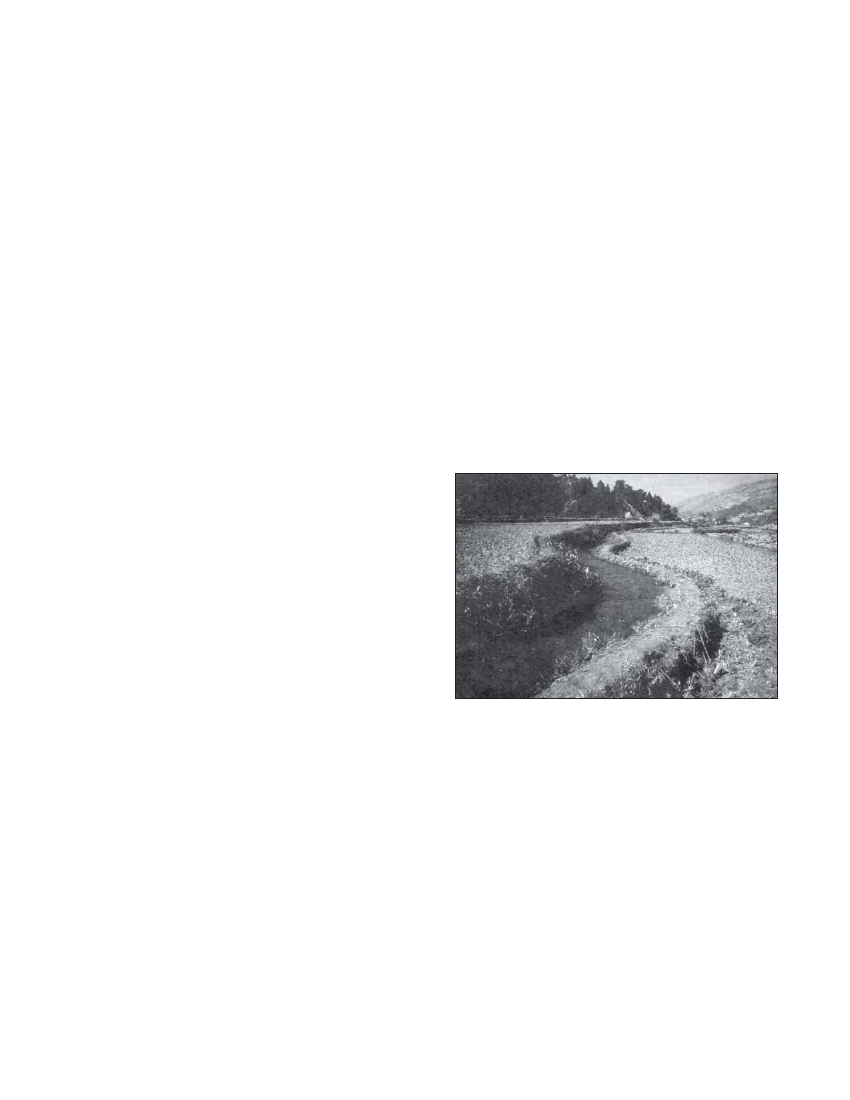
CIVIL WORKS GUIDELINES FOR MICRO-HYDROPOWER IN NEPAL
39
4. Headrace
4.1 Overview
The headrace of a micro-hydropower scheme is a canal or a
pipe that conveys water from the intake to the forebay. The
headrace alignment is usually on even to gently sloping ground
and the flow is caused by gravity. A headrace pipe is generally
not subjected to significant hydraulic pressure.
Since canals are generally less expensive than pipes, they are
used more often for headraces in micro-hydro schemes. The
general rule is to use canals as often as possible and to use
pipes only for the difficult stretch of the headrace alignment,
such as to negotiate cliffs or unstable areas.
Micro-hydro headrace canals are similar to farmer managed
small irrigation canals in that they are designed to keep
seepage, friction and erosion to a minimum. However, there
are also some basic differences as follows:
Irrigation canals are used only 3-6 months in a year whereas
micro-hydro schemes require water throughout the year.
In irrigation canals, some variation in flows does not create
much problem, and temporary repairs (e.g. placing of
branches and leaves at a leaking section of a canal) can be
made. The headrace canal in a micro-hydro scheme needs
to be more reliable.
The loss of head over the length of the headrace should be
minimised so that power output can be optimised.
Some micro-hydro texts use the term power canal/ conduit
for either the length between the intake and the settling
basin (when this structure is separate from the forebay) or
for the entire headrace. In this text the term headrace is
used in all cases.
The velocity in the initial headrace length needs to be high
enough to carry gravel and sediment up to the gravel trap
and settling basin respectively. Where there is a separate
settling basin and forebay, the velocity in the headrace
between these structures can be lowered since it will carry
sediment free flow.
4.2 Canal types
Headrace canals can be classified according to the materials
used to construct them. Various types of headrace canal used
in micro-hydro schemes are as follows:
4.2.1 EARTH CANALS
These are constructed by simply excavating the ground to the
required shape. Such canals are used on stable and gently
sloping ground. Seepage can be high in such canals depending
on soil type. If there are signs of instability in a headrace
section, or if seepage from the canal is likely to contribute to
slope instability such as landslides, this type of canal should
not be selected. However, for headrace alignments on stable
ground where seepage is not likely to cause instability, earth
canals are the most economic option.
Where clay is locally available it could be considered as a
lining to reduce seepage from earth canals. However, a scheme
Photo 4.1 Earth Channel (Dhading)
in Syangja successfully used a clay lining protected by stone
pitching for the peaking reservoir (which was fenced off) but
in the headrace canal the lining was destroyed by cattle.
4.2.2 STONE MASONRY IN MUD MORTAR CANALS
If an earth canal does not appear to be feasible, the second
option to be considered is stone masonry in mud mortar type.
Compared to an earth canal, there will be less seepage from
this type of canal. For similar flows, the cross section of this
type of canal can be smaller than the earth canal because a
higher velocity is acceptable (without causing erosion) as will
be discussed later. An example of a stone masonry canal in
mud mortar can be seen in Photograph 4.2.
4.2.3 STONE MASONRY IN CEMENT MORTAR CANALS
In terms of cost, this is usually the least preferable option for
a headrace canal. The advantage with this type of canal is
that seepage is minimal (i.e. significantly less than stone